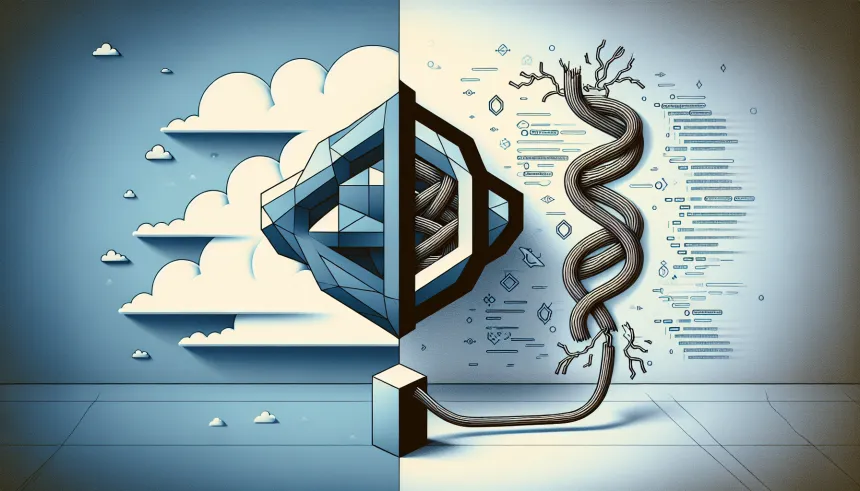When it comes to infrastructure management, my preference leans heavily towards tools like Terraform rather than Cloud Development Kits (CDKs). Why? Terraform’s declarative approach, where you define what you want rather than how to do it, makes it more reliable for long-term maintenance. Keep reading to understand my perspective.

Separation of Concerns
Developers and operations teams have different areas of expertise. Developers should focus on writing and maintaining code, while operations should manage infrastructure. Expecting ops teams to be proficient in the latest JavaScript, TypeScript, or whatever new fancy framework comes along creates unnecessary complexity and hinders their primary responsibilities. This is especially important when working with complex systems like Kubernetes clusters or container registries.
Infrastructure management shouldn’t need to be entangled with the rapid evolution of development frameworks.
Longevity and Stability
Infrastructure tends to outlive codebases. In my experience, I’ve seen that tools like Terraform, which rely on straightforward configuration files, tend to age far better than high-level abstractions like CDKs. A “bash script” written today will likely still function 10-15 years from now with minimal changes. In contrast, a JavaScript-based solution could be a nightmare to revive after a decade, due to dependency hell and versioning issues. I’ve often found myself migrating complex Python or Node.js setups to simpler, more durable bash scripts as projects evolve or versions gets deprecated.
Dependency and Versioning Challenges
NPM package management, with its tangled web of dependencies, can become a significant pain point over time. The more abstracted your solution, the more brittle it becomes, especially as dependencies change or deprecate. With infrastructure, stability is key. A broken package could bring down your entire application if your infrastructure is too tightly coupled with high-level abstractions.
Highly abstracted solutions may be easier to implement initially but can become increasingly difficult to maintain and change over time. If a bug arises within these layers, it can be incredibly challenging to debug and resolve without risking your entire infrastructure. The simpler and more direct your infrastructure management, the easier it is to maintain in the long run.
Developers Changing Infrastructure. Bad Idea
One of the key dangers of CDKs is that they make it easier for developers (who may not have deep infrastructure knowledge) to make significant changes to infrastructure. While it’s appealing to empower developers with more control, it also introduces substantial risk. Infrastructure changes are complex and can have wide-reaching implications if something goes wrong. If a developer unfamiliar with the intricacies of infrastructure management inadvertently introduces a misconfiguration, it could lead to significant downtime or security vulnerabilities.
Tools like Terraform help enforce a clearer separation, where infrastructure remains under the purview of those who specialize in it, reducing the risk of unintentional errors. Remember, Terraform is declarative, so you just define what you want and Terraform will make it happen following the correct steps. Even for developers, Terraform should be the tool of choice. This is particularly important when managing DevOps workflows and automated deployments.
Use Cases Where CDKs Shine
Don’t get me wrong, CDKs are super useful and have their place, particularly in SaaS platforms where infrastructure provisioning is tied directly to user actions. For example, when building serverless applications, CDKs make sense as they allow developers to integrate resource deployment seamlessly into their applications. However, for long-term infrastructure that underpins your business, tools like Terraform or CloudFormation are more suitable. They require minimal maintenance compared to code-based solutions and are better suited for managing stable, long-lived infrastructure.
My Preference
Personally, I favor Terraform due to its built-in drift detection and cloud-agnostic nature. Terraform allows you to mix and match providers, pulling in data from various sources to orchestrate complex, multi-cloud deployments. Achieving this level of flexibility with CDKs would require each cloud provider to offer a compatible CDK, which is rarely the case. Additionally, integrating bash scripts with Terraform configurations is straightforward, adding another layer of simplicity and reliability.
Conclusion
If you’re building and maintaining infrastructure critical to your business, stick with Terraform or CloudFormation. They’re stable, reliable, and won’t require you to keep up with the latest trends in programming languages or frameworks. On the other hand, if your infrastructure is part of a SaaS offering where user-driven provisioning is key, CDKs might be the better choice. But for long-term stability, nothing beats the simplicity and robustness of Terraform.
This is why, in my view, Terraform is the better tool for long-term infrastructure maintenance. It’s a tool that doesn’t just work well today, but will continue to serve you reliably for years to come. For more insights into cloud infrastructure management, check out my article on testing new cloud instance types.
For those interested in optimizing their infrastructure further, you might want to explore my guides on dealing with large Docker images and setting up cross-region container registries. These resources can help you build a more robust and efficient infrastructure using Terraform.